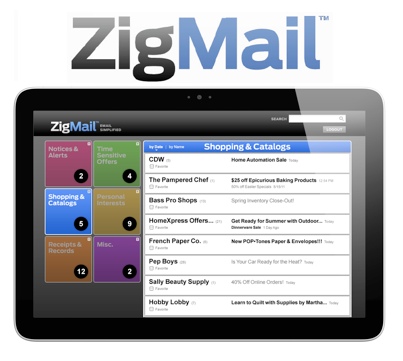
ZigMail is a nifty new email service that gives you control over all those personal so-called “transactional” emails that clog up your inbox — you know, the ones from your bank, mortgage company, health insurance, retailers or any other ongoing vendors in your life.
[aditude-amp id="flyingcarpet" targeting='{"env":"staging","page_type":"article","post_id":390023,"post_type":"story","post_chan":"none","tags":null,"ai":false,"category":"none","all_categories":"business,cloud,entrepreneur,","session":"C"}']These emails aren’t spam. But they’re annoying: They keep coming, but they’re too important to delete, and easily lost amid the flood. Is your bank account overdrawn? Has there been a raise in your mortgage rate? Given the email overload these days, we’re likely to miss some critical updates in these emails.
Here’s how ZigMail works to combat that problem: First, it identifies all of those important transactions emails — from your bank, retailers, etc. — and removes them from your inbox. It then puts them into a separate online account at ZigMail.com where you can access them whenever you want to.
AI Weekly
The must-read newsletter for AI and Big Data industry written by Khari Johnson, Kyle Wiggers, and Seth Colaner.
Included with VentureBeat Insider and VentureBeat VIP memberships.
It doesn’t mean you have to check the separate ZigMail account all the time. In fact, you can simply keep reading your regular email account. The ZigMail service sends you a daily digest — each morning — notifying you of the latest incoming transaction email. It’s a sort of reminder of what’s going on in your life. And it’s useful because it’s contained in a single place.
I just tried out the service — which is formally launching today — and found it works quite well.
Once I switched over to my ZigMail account, I could see all of my transaction email organized into categories (as seen in the image top left). There’s a categories for things like “receipts & records,” “notices and alerts,” “shopping & catalogs,” and more. You can see them all in a single email view, or by these categories.
You can delete these emails, or click through and read them.
The great thing is, all of these emails are also stored in a “ZigMail” folder in your main email account, in my case Gmail. The two aren’t synced. So if you delete an email from you ZigMail account, the corresponding email over in your main email account remains intact. And vice versa. In that sense, Zigmail can also be considered a disaster recovery backup.
Finally, one useful feature is that you can give out your ZigMail email address — yes, ZigMail assigns you an email account for this — so that vendors send stuff to this email account to start with and they don’t clog your other email.
[aditude-amp id="medium1" targeting='{"env":"staging","page_type":"article","post_id":390023,"post_type":"story","post_chan":"none","tags":null,"ai":false,"category":"none","all_categories":"business,cloud,entrepreneur,","session":"C"}']
Here’s the big risk for ZigMail. It asks for your main email account and password so that it can do the filtering for you. That takes a lot of trust, and I’m wondering how this will play with the masses. I took the risk, simply because I trust the founders of the company. I met them last week, and CEO Richard Gerstein has a credible track-record, holding executive positions at HP, Sears and P&G. Notably, Gerstein says that 68 percent of users signing up with ZigMail went ahead and gave their email and password. Since the company’s soft-launch two weeks ago, the company says it has gotten more than 4,000 users.
The company is offering its service for free. It plans to make money by placing advertising on the margins of your ZigMail account (it’s not that intrusive, at least for now). It plans to start offering brands and other companies a way to customize the emails they send to you — but at least these will be only on emails from companies you already have relationships with.
Some 67 percent of emails in the average inbox are commercial, ZigMail says. If true, this suggests ZigMail is tackling a very real problem.
ZigMail, based in Chicago, and recently expanding to Silicon Valley, has spent $250,000 in funding so far, and is looking to raise its first round within the next three months.
[aditude-amp id="medium2" targeting='{"env":"staging","page_type":"article","post_id":390023,"post_type":"story","post_chan":"none","tags":null,"ai":false,"category":"none","all_categories":"business,cloud,entrepreneur,","session":"C"}']
Below is a video showing how the product works:
VentureBeat's mission is to be a digital town square for technical decision-makers to gain knowledge about transformative enterprise technology and transact. Learn More
